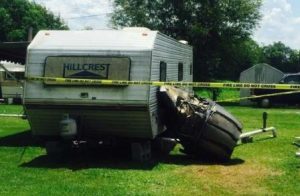
REPORT FROM NTSB:
BERKELEY COUNTY, S.C.–On July 7, 2015, at 1100 eastern daylight time, a Cessna 150M, N3601V, and a Lockheed-Martin F-16CM, operated by the U.S. Air Force (USAF), collided in midair near Moncks Corner, South Carolina.
The Cessna was destroyed during the collision, and both the private pilot and passenger were fatally injured. The damaged F-16 continued to fly for an additional 3 minutes until the pilot activated the airplane’s ejection system.
The F-16 was destroyed following the subsequent collision with terrain and post-impact fire, while the pilot landed safely and was uninjured. Visual meteorological conditions prevailed, and no flight plan was filed for the Cessna, while the F-16 was operating on an instrument flight rules flight plan.
The Cessna departed from Berkley County Airport (MKS), Moncks Corner, South Carolina, at 1057, and was destined for Grand Strand Airport (CRE), North Myrtle Beach, South Carolina; the personal flight was conducted under the provisions of Title 14 Code of Federal Regulations Part 91. The F-16 had departed from Shaw Air Force Base (SSC), Sumter, South Carolina about 1020.
According to the USAF, after departing from SSC, the F-16 proceeded to Myrtle Beach International Airport (MYR), Myrtle Beach, South Carolina, where the pilot conducted two practice instrument approaches before continuing the flight to Charleston Air Force Base/International Airport (CHS), Charleston, South Carolina. According to preliminary air traffic control (ATC) radar and voice communication data provided by the Federal Aviation Administration (FAA), the F-16 pilot contacted the approach controller at CHS about 1052 and requested to perform a practice tactical air navigation system (TACAN) instrument approach to runway 15.
The controller subsequently instructed the F-16 pilot to fly a heading of 260 degrees to intercept the final approach course. At 1055, the controller instructed the F-16 pilot to descend from his present altitude of 6,000 feet to 1,600 feet. About that time, the F-16 was located about 34 nautical miles northeast of CHS.
At 1057:41, a radar target displaying a visual flight rules transponder code of 1200, and later correlated to be the accident Cessna, appeared in the vicinity of the departure end of runway 23 at MKS, at an indicated altitude of 200 feet. The Cessna continued its climb, and began tracking generally southeast over the next 3 minutes.
For the duration of its flight, the pilot of the Cessna did not contact CHS approach control, nor was he required to do so. At 1100:18, the controller advised the pilot of the F-16, “traffic 12 o’clock, 2 miles, opposite direction, 1,200 [feet altitude] indicated, type unknown.”
The F-16 pilot responded and advised the controller that he was “looking” for the traffic. At 1100:26, the controller advised the F-16 pilot, “turn left heading 180 if you don’t have that traffic in sight.” The pilot responded by asking, “confirm 2 miles?” Eight seconds later, the controller stated, “if you don’t have that traffic in sight turn left heading 180 immediately.” Over the next 18 seconds, the track of the F-16 began turning southerly.
At 1100:49, the radar target of the F-16 was located 1/2 nautical mile northeast of the Cessna, at an indicated altitude of 1,500 feet, and was on an approximate track of 215 degrees. At that time, the Cessna reported an indicated altitude of 1,400 feet, and was established on an approximate track of 110 degrees. At 1100:52 the controller advised the F-16 pilot, “traffic passing below you 1,400 feet.”
At 1100:54, the radar reported altitude of the F-16 remained at 1,500 feet and no valid altitude information was returned for the radar target associated with the Cessna. At that point the targets were laterally separated by about 1,000 feet. No further radar targets were received from the Cessna, and the next radar target for the F-16 was not received until 1101:13. At 1101:19, the F-16 pilot transmitted a distress call, and no subsequent transmissions were received. Air traffic control radar continued to track the F-16 as it proceeded on a roughly southerly track, and after descending to an indicated altitude of 300 feet, radar contact was lost at 1103:17 in the vicinity of the F-16 crash site.
The wreckage of the Cessna was recovered in the vicinity of its last observed radar target, over the west branch of the Cooper River. Components from both airplanes were spread over an area to the north and west of that point, extending for approximately 1,200 feet.
The largest portions of the Cessna’s airframe included a relatively intact portion of the fuselage aft of the main landing gear, and the separate left and right wings, all of which were within 500 feet northwest of the airplane’s final radar-observed position. Portions of the cabin interior, instrument panel, fuel system, and engine firewall were found distributed throughout the site.
The engine, propeller, and nose landing gear assembly were not recovered. The lower aft engine cowling of the F-16 was also recovered in the immediate vicinity of the Cessna’s aft fuselage, while the F-16’s engine augmenter was recovered about 1,500 feet southwest. Small pieces of the F-16’s airframe were also distributed throughout the accident site.
Both of the Cessna’s wings displayed uniform leading edge crush damage throughout their spans that was oriented aft and upward. Paint transfer and rub markings oriented in a direction from the airplane’s left to right were observed on the upper forward surfaces of both wings.
Both fuel tanks were ruptured, and evidence of heat damage and paint blistering were observed on the upper surface of the right wing. Flight control continuity was traced through overload-type cable separations from the cabin area to each flight control surface. Measurement of the pitch trim actuator showed a position consistent with a 3 to 4-degree deflection of the tab in the nose down direction, and measurement of the flap actuator showed a position consistent with the flaps having been in the retracted position.
The F-16 wreckage site was located about 6 nautical miles south of the Cessna wreckage site. The F-16 wreckage path was about 700 feet long and oriented roughly 215 degrees, with portions of the airframe distributed along the wreckage path. The wreckage displayed significant ground impact and post-impact fire-related damage.
A crash-survivable memory unit (CSMU) was recovered from the wreckage, and the digital flight control system seat data recorder (DFLCS SDR) was recovered from the airplane’s ejection seat. Both memory units were forwarded to the airframe manufacturer for data extraction under the supervision of an NTSB Vehicle Recorder Specialist.
The weather conditions reported at MKS at 1055 included calm winds, 10 statute miles visibility, scattered clouds at 2,600 feet agl, a temperature of 30 degrees C, a dew point of 22 degrees C, and an altimeter setting of 30.15 inches of mercury.
*This is preliminary information, subject to change, and may contain errors. Any errors in this report will be corrected when the final report has been completed. NTSB investigators either traveled in support of this investigation or conducted a significant amount of investigative work without any travel, and used data obtained from various sources to prepare this aircraft accident report.














Recent Comments